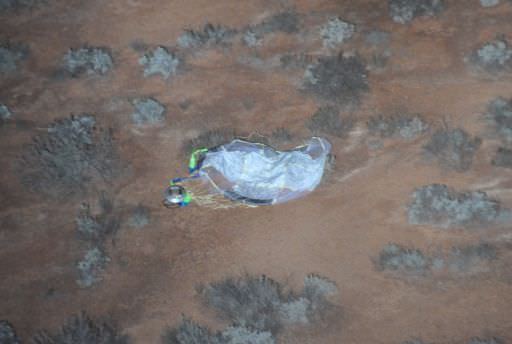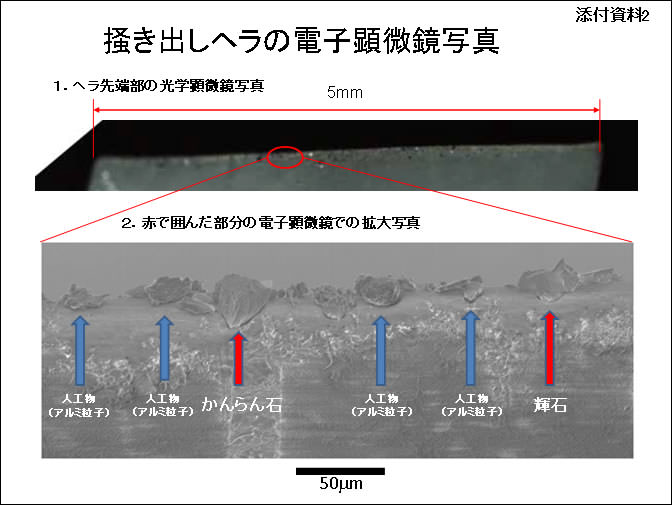[/caption]
The Japan Aerospace Exploration Agency (JAXA) has confirmed that the tiny particles inside the Hayabusa spacecraft’s sample return container are in fact from the asteroid Itokawa. Scientists examined the particles to determine if the probe successfully captured and brought back anything from the asteroid, and in a press release said “about 1,500 grains were identified as rocky particles, and most were determined to be of extraterrestrial origin, and definitely from Asteroid Itokawa.”
These are the first samples from an asteroid ever returned to Earth; the only other extraterrestrial samples brought back to Earth came from the Apollo missions to the Moon. See correction, below.
Previously, JAXA said that although particles were inside the container, it wasn’t clear if they were from the asteroid or if they could be of terrestrial origin (dust from Earth that could have been inside the container).
The particles samples were collected from the chamber by a specially shaped Teflon spatula and examined with a scanning electron microscope. There were two chambers inside the container, and from the press release (in Japanese) it appears all the particles were found in one chamber, Chamber A.
Most of the particles are extremely small, about 10 microns in size and require special handling and equipment. Unfortunately they aren’t the “peanut-sized” chunks of rock that the mission originally hoped to capture. This will make analyzing the particles difficult, but not impossible.

During the seven-year round trip journey, Hayabusa arrived at Itokawa in November, 2005. The mechanism that was intended to capture the samples apparently failed, but scientists were hopeful that at least some dust had made its way into the return canister. After a circuitous and troubled-filled return trip home, the sample return capsule was ejected and landed in Australia in June of this year.
Here are the other successful sample return missions:
Apollo Moon missions (1969-1972)
Soviet Union’s Luna 16 (1970) returned 101 grams of lunar soil
Luna 20 (1974) returned 30 grams
Luna 24 (1976) returned 170.1 grams.
The Orbital Debris Collection (ODC) experiment, deployed on the Mir space station for 18 months during 1996–1997, used aerogel to capture interplanetary dust particles in orbit.
Genesis (2001-2004) captured and returned molecules collected from the solar wind. It crashed in the Utah desert, but samples were able to be retreived.
Stardust (1999-2006) collected particles from the tail of a comet, as well as a few interstellar dust grains.
Source: JAXA


BINGO! Congratulations. Wonderful feat of engineering, ingenuity and resilience. All that remains is to make a movie about the ordeal.
/hydrazine
Yeah! Notch yet another one up for non-US space exploration!
It is about time the ol’ USA starts to recognises the huge steps being made by places like Japan, China, India and the ESA. To long has undeserved contempt has been shown for the remarkable contributions they are making in recent years. Just goes to show the significant effects of having a booming economy and willingness to go the hard yards
As for saying (in the second paragraph mind you!!) ;”These are the first samples from an asteroid ever returned to Earth; the only other extraterrestrial samples brought back to Earth came from the Apollo missions to the Moon.” What typical bias!!!! How about all them meteorites then?
Why is it that every time some new milestone is reached by the aerospace outside the US, it has to be compared to some relic of ancient history in the past like Apollo? Really.Glory days are nothing compared to cutting-edge of exploration.
(Note: This very same ‘stunt’ was made in the 11th Nov IUniverse Today article “First Images From Chang’E 2 Released” At least that appeared in Paragraph 4!)
The Honorable Crumb quoth:
“As for saying (in the second paragraph mind you!!) ;”These are the first samples from an asteroid ever returned to Earth; the only other extraterrestrial samples brought back to Earth came from the Apollo missions to the Moon.” What typical bias!!!! How about all them meteorites then?”
Indeed sir, indeed. Not to mention the dust collected from Wild 2 by the Stardust mission.
Hi,
The only other time since Apollo samples were returned? didn’t the Soviets do a sample return around the same time as Apollo? Also what about the comet sample return from stardust?
The Hayabusa mission continues! Excellent! Go JAXA!
Sweet!
Can we open the B container to Yule, pretty please!?
Sorry about my last post, but it is about time we have stories that barracks for the other teams too, instead of backing the the favourite all the time.
This time Japan really deserves the kudos!
You are right about this, and the future looks worse. The American space science program is going to fall off later in the 2020s. Programs for the 2030 time frame should be on the drawing board now, and they are absent. So the future will not only see the rest of the world’s science market share grow, but our shrink.
Sigh,
LC
I think the reason new milestones are compared with the one NASA achieved is because they did so much so quickly across many disciplines and they stood as markers for such along time. These comparisons are quite natural. Every day we hear that such and such a soccer team has gone 15 games unbeaten at home without conceding a goal – the first time since Pteranodon United acieved 14 games unbeaten in 1905. Nothing wrong with doing that.
In addition to the sample return missions listed above, NASA maintains samples of interplanetary dust collected in the stratosphere by suitably equipped U-2, ER-2 and WB-57 aircraft. NASA has made these samples available to researchers(this listing as of 2006): http://curator.jsc.nasa.gov/dust/list.cfm
Specific attempts were made to collect dust particles from Comet 55P/Temple-Tuttle in 2002 (during the Leonid meteor shower) and in 2003 from Comet Grigg-Skjellerup, but these were considered long shots and no positive IDs were made IIRC. Further details of these attempts are can be found at the same link.